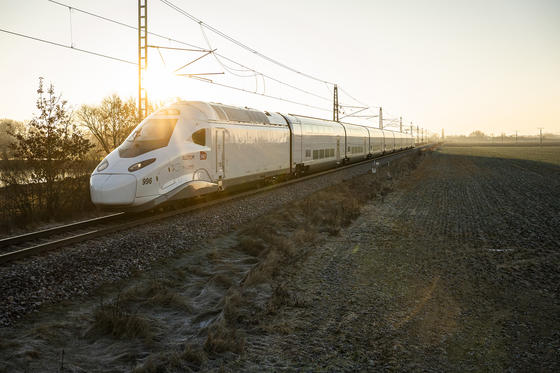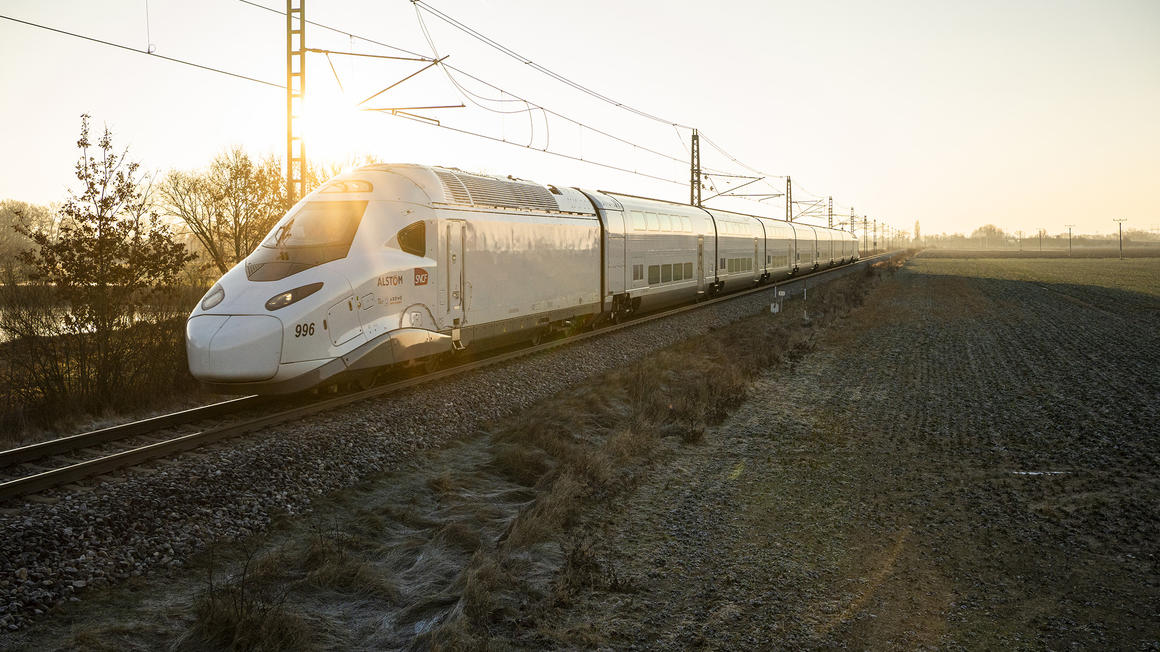
TGV M launches its first dynamic tests in the Czech Republic
Press contact - Philippe Molitor
Philippe Molitor
Send an emailFebruary 9, 2023 – Since December 7, 2022, the first TGV M test train, from Alstom's Avelia Horizon range, has been at the Velim test site in the Czech Republic. This test campaign will last almost 6 months and is part of a long series of tests for this new generation of High Speed Trains.
Decisive test campaigns for the admission of the train and its reliability
The TGV M test programme consists of the following phases:
1. Static and quasi-static testing:
Each piece of equipment on the train was first assessed separately to validate its own performance and service life. Then, once assembled, the test train was tested at Alstom's Bellevue site (in France) at a standstill and then at a speed not exceeding 30 km/h. The operation of all the equipment integrated into the train was checked, as were the interactions of this equipment with each other.
2. Pre-validation testing:
The pre-validation tests are first conducted on the Velim site. This is a closed circuit where traffic is less constrained than on the national railway networks and, above all, there is no interaction with commercial traffic. The objectives here are to validate the overall operation of the train, to remove the risks that appeared during the design phase in relation to the regulatory requirements and to adjust the digital modelling accordingly. This phase takes place at speeds of up to 200 km/h.
On the basis of this sequence, the tests will then continue with traffic on the French national network. The overall operation of the train will be tested up to 320 km/h.
3. Admission tests:
They consist of testing the operation by reproducing the configurations and contexts that the train may encounter throughout his entire life (degraded modes, weather conditions, obstacles on the network, etc.). They will be carried out on the French national network, with traffic up to 320 km/h by an accredited organisation. The admission tests will make it possible to obtain the Commercial Service Authorisation issued by the ERA (European Railways Agency).
4. Endurance tests:
Over a long period prior to commercial operation, several trainsets will run throughout the French national network to test the reliability of the train under real operating conditions. All functions will be tested, in particular those relating to passenger comfort. These tests will also be an opportunity for SNCF Voyageurs drivers and conductors to familiarise themselves with this new train and its innovations.
At the end of all these tests, the TGV M will have benefited from a total of 350 weeks of testing and will have covered more than a million kilometres before the first customer experiences the high-speed train of tomorrow.
-
6months of tests
-
115TGV M ordered to date
-
-20%less energy consumption
6 months of tests in Velim before joining the French railway network
Pre-validation tests needed for the dynamic development of the TGV M are currently being carried out at Velim by Alstom with the support of the Test Agency of the ‘SNCF Voyageurs’ Equipment Engineering Department.
The Velim test site, equipped with high-performance infrastructure, consists of a ring where rolling stock can run at up to 200km/h. On arrival at Velim, the TGV M began its tests and a gradual increase in speed to 200km/h was successfully achieved in less than a week. A very short time, well under the forecasts. Once this stage was over, the first phases of functional development tests began: braking without load and under load, pantograph tests, signalling tests (communication between the train and the ground infrastructure), etc.
Still in progress, this key sequence aims to ensure compliance with the safety requirements for railway operations and to submit the Request for Authorisation to Run a Test Train on the French National Railway Network (RARTT).
This test campaign also allows SNCF Voyageurs drivers to take charge of the train and discover their working environment. The driver's cab was carefully designed with the support of SNCF drivers to ensure that it meets their needs in terms of comfort, space and ergonomics.
Next steps
Climatic tests in Vienna in early March
Another power car dedicated to climatic tests will leave the Alstom site of La Rochelle in mid-February for the test site in Vienna, Austria.
These tests are crucial in the current context of global warming/disruption. The aim is to evaluate energy efficiency. Indeed, the creation of optimal thermal comfort inside a vehicle leads to high energy consumption by auxiliary systems (ventilation, air conditioning).
From the beginning of March, tests in a climatic chamber will begin on site. They will be conducted over a temperature range of -20°C to +40°C. The programme includes:
- Simulation of sunshine up to 800 W/m²
- Wind simulation up to 160 km/h
- Tests of heating, air conditioning, insulation of the undercarriage as well as the driver's cab and passenger cars.
Not only is this part of the train qualification process, but it will actively contribute to the planned 20% reduction in energy consumption of the TGV M.
Tests on the National French Railway Network in Spring
Thanks to the success of these various steps, the tests will be able to begin on the French National Railway Network: the train will be tested at 320km/h in Spring 2023.
Higher capacity, more ecological, better connectivity, better accessibility
115 units have been ordered to date (100 domestic and 15 international trainsets). The TGV M will be used for both the INOUI and OUIGO TGV services and is characterised by major innovations:
- Unprecedented modularity, which makes it possible to adjust the number of cars as closely as possible to market needs (7, 8 or 9), to rapidly transform a 1st class space into a 2nd class space and vice versa, to reconfigure the interior by removing or adding seats, bicycle or luggage spaces, etc.
- A 20% increase in on-board space, i.e. a possible offer of up to 740 seats compared to the current maximum of 634.
- Ultra-competitive energy efficiency and carbon footprint per passenger: the TGV M's carbon footprint is the lowest on the market and 97% of the train's components are recyclable. With a 32% reduction in CO² emissions, the TGV M is fully in line with the SNCF Group's environmental commitments, as set out in the SNCF Voyageurs "Planète Voyages" programme, which aims to reduce the carbon footprint and energy consumption of all its activities.
- Access to evolving connected services that meet passengers' needs, such as on-board Wi-Fi, as well as complete information in real time in the different areas of the train.
- A highly "communicating" train set whose sensors continuously transmit thousands of pieces of data enabling the train to be examined in real time from every angle to optimise maintenance and availability,
- Increased accessibility on board, for the benefit of all passengers.
TGV M, a project supported by the French government through ADEME and the ‘Secrétariat Général Pour l'Investissement’ (SGPI), with the first train sets scheduled to enter commercial service at the end of 2024, has benefited from the knowledge of Alstom's top experts and SNCF Voyageurs' Matériel and TGV-INTERCITES departments, brought together on a common platform.
Alstom™ and Avelia Horizon™ are protected trademarks of the ALSTOM Group.


